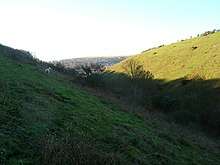Lewes Downs
Lewes Downs is a 165-hectare (410-acre) biological Site of Special Scientific Interest east of Lewes in East Sussex.[1][2] It is a Nature Conservation Review site, Grade I[3] and a Special Area of Conservation.[4] Part of it is a National Nature Reserve,[5] part is Malling Down nature reserve, which is managed by the Sussex Wildlife Trust,[6] and part is Mount Caburn, an Iron Age hill fort which is a Scheduled Monument.[7]
| Site of Special Scientific Interest | |
 | |
| Area of Search | East Sussex |
|---|---|
| Grid reference | TQ 437 099[1] |
| Interest | Biological |
| Area | 165.0 hectares (408 acres)[1] |
| Notification | 1986[1] |
| Location map | Magic Map |
This south-facing slope on the South Downs is ecologically rich chalk grassland and scrub. Flora include the nationally rare early-spider orchid and it also has a diverse invertebrate fauna and an important breeding community of downland birds.[8]
References
- "Designated Sites View: Lewes Downs". Sites of Special Scientific Interest. Natural England. Retrieved 16 January 2019.
- "Map of Lewes Downs". Sites of Special Scientific Interest. Natural England. Retrieved 16 January 2019.
- Ratcliffe, Derek, ed. (1977). A Nature Conservation Review. 2. Cambridge, UK: Cambridge University Press. pp. 116–17. ISBN 0521 21403 3.
- "Designated Sites View: Lewes Downs". Special Areas of Conservation. Natural England. Retrieved 10 January 2019.
- "Designated Sites View: Lewes Downs (Mount Caburn)". National Nature Reserves. Natural England. Retrieved 10 January 2019.
- "Malling Down". Sussex Wildlife Trust. Retrieved 20 December 2018.
- Historic England. "Hillfort, bowl barrow and associated remains on The Caburn (1014527)". National Heritage List for England. Retrieved 16 January 2019.
- "Lewes Downs citation" (PDF). Sites of Special Scientific Interest. Natural England. Retrieved 16 January 2019.
This article is issued from Wikipedia. The text is licensed under Creative Commons - Attribution - Sharealike. Additional terms may apply for the media files.